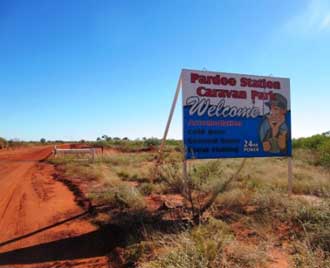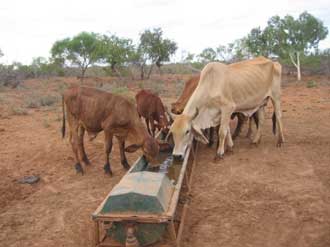Cape Keraudren Reserve marks the beginning of a picturesque white-sand beach that stretches as far as the eye can see - the famous Eighty Mile Beach. The clear blue water is a spectacular welcome. Follow one of several walking trails through the reserve to see the diverse flora and fauna native to this pristine coastline, or just sit back and relax on the magnificent beach.
A good spot for fishing, you might be fortunate enough to be cooking your catch while watching a magnificent sunset over the ocean.

The reserve has plenty of predominantly 4WD tracks which lead to some wonderful spots where you can view kangaroos, bulls grazing, mangroves and lagoons. At low tide, the water recedes up to one and half kilometres, exposing a coral reef.
Down at the water's edge, at low tide you can to walk out onto a coral reef that the tide exposes for up to one and a half kilometres. The low tide exposes marvellous reefs holding myriads of marine life from tiny roaming sea urchins, octopus, mud crabs, fish, beautiful clusters of corals.
The beach near the main camping area is long and wide, and at low tide the water recedes up to an amazing 3 kilometres! This reveals hundreds of hermit crabs making their way across the sand from Cootenbrand Creek, an array of shells and rock pools holding hundreds of fish that didn't get out with the tide.��

Pardoo Station
Pardoo is a working cattle station which also provides accommodation options for caravans, families, backpackers and corporate clients.
Pardoo Station covers 500,000 acres (2023 square kms) and is home to approximately 7000 head of Santa Gertudis cattle and some Brahman. The muster crews use 4WDs and are assisted by a chopper to bring the cattle into the yards. If you are staying in the park during the muster season you are almost guaranteed to witness the cattle muster and cattle work taking place right outside your caravan.

Where is it?
The Cape Keraudren Coastal Reserve is located 179 km north of Port Hedland on the Great Northern Highway, and 13 km west via the Cape Keraudren Access Road.
The Name
Cape Keraudren was named on 30 July 1801 by French explorer Nicolas Baudin. He named it after Pierre Francois Keraudren (1769-1858), Medical Inspector of the French Navy. Keraudren authored numerous works on the diseases of seamen.
Pardoo was originally established as an outstation of De Grey Station, when Padbury took stock north to De Grey in the 1860s. He later abandoned the area and it was then taken up by A.E. Anderson, Harper and Grant in 1869. Later Harper was replaced by Edgar.Another change was to come about when the Pardoo section was sold off in 1902 to frank Snellgrove Thompson, Medcalf and Rounsville. They were all bought out by Thompson in 1904.
Mount Goldsworthy mine site
Mount Goldsworthy, located on the South Western side of the lease, is the site of the first iron ore mine in the Pilbara region of Western Australia. The Pardoo mine, also an iron ore mine, is located in the region, too, and shares the stations name.
Fishing is by far the most popular past time for people staying on Pardoo Station. The station has three tidal creeks and 16km of fishable coastline that is accessible by well-maintained bush tracks. Some of the more commonly caught fish are: Bluenose salmon, threadfin salmon, whiting, bream, mangrove jack, cod, and barramundi (late in the year).
Pardoo Roadhouse
Pardoo Roadhouse Tavern and Accommodation is located 14 km from Cape Keraudren on the Great Northern Highway between Broome (460km) & Port Hedland (150km). It is one of the few roadhouses between Port Hedland and Broome.
Design by W3Layouts | Content © 2013 Phoenix Group Co. | Sales: phone 1300 753 517, email: [email protected]

